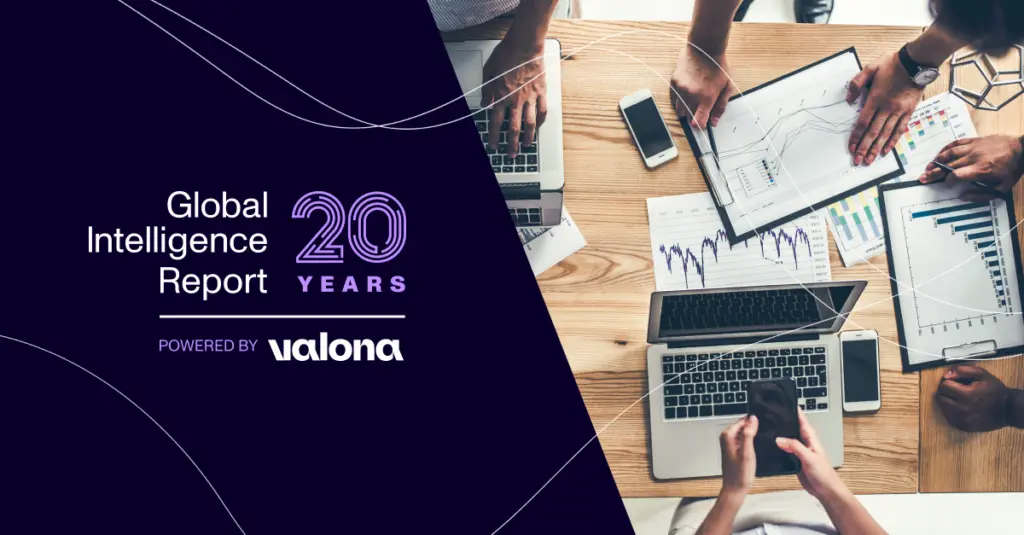
How Strategic Foresight Drives Business Innovation
Learn how strategic foresight enhances innovation by identifying trends, building scenarios, and fostering adaptability for resilient, future-ready strategies.
With strategic foresight, organizations can plan for the future by identifying trends and potential challenges early, they can also adapt quickly and take advantage of new opportunities. However, putting foresight into practice can feel complicated without clear tools and strategies to guide the process.
This article outlines how organizations can apply strategic foresight to enhance innovation and business strategies:
- Conducting trend analysis
- Building future scenarios
- Promoting collaboration across teams
- Integrating foresight into everyday planning
- Using technology and data for predictions
- Building a flexible, innovative culture
What is strategic foresight?
Strategic foresight is a structured way of looking ahead to prepare for future challenges and opportunities. Unlike traditional planning, which often focuses on solving immediate problems, foresight is about exploring possibilities and anticipating what might come next.
While some may confuse strategic foresight with forecasting, the two are different. Forecasting aims to predict specific outcomes, whereas strategic foresight helps organizations consider a range of potential futures and develop strategies to adapt.
“Strategic foresight isn’t about predicting the future—it’s about preparing for it.”
This approach allows businesses to identify trends, understand potential disruptions, and plan proactively. For example, strategic foresight can help companies innovate by recognizing shifts in customer behavior or emerging technologies before competitors do. It’s not just about reacting to change but shaping the future direction of the organization.
Why is strategic foresight important?
Strategic foresight plays a key role in helping businesses navigate uncertainty and plan for the future. By anticipating potential challenges and opportunities, organizations can make informed decisions and stay ahead of the competition.
Broadly, the importance of strategic foresight can be seen in four key areas:
- Helping businesses prepare for uncertainty ensures that companies can anticipate disruptions rather than react to them. By identifying shifts in customer preferences, adapting to market dynamics, or embracing technological advancements, businesses can remain agile and resilient.
- Encouraging innovation is another crucial benefit. Strategic foresight pushes organizations to explore future possibilities, uncover growth opportunities, and inspire creative thinking beyond immediate challenges. This approach fosters a culture of long-term innovation.
- Improving decision-making enables businesses to align their strategies with emerging trends and act with clarity. By understanding potential future scenarios, leaders can make timely, well-informed choices that position their organizations for success.
- Supporting long-term success allows businesses to thrive, not just survive. Staying ahead of the curve with a proactive mindset ensures that companies can achieve sustained growth and adapt to an evolving environment.
Strategic foresight offers a clear path for organizations to remain competitive and innovative in an ever-changing landscape.
Want to turn strategic foresight into a competitive advantage?
Get instant access to 8 exercises and activities designed to help you build foresight into your decision-making processes from Valona’s Strategic Foresight Playbook! In addition, our market intelligence solution offers real-time insights into trends, scenarios, and emerging opportunities. Stay ahead, adapt faster, and make smarter decisions with ease. Explore how our platform empowers you to navigate the future confidently—start your journey today!
How organizations can apply strategic foresight to enhance innovation and business strategies
1. Conducting trend analysis
The first step in applying strategic foresight is conducting trend analysis, which involves identifying emerging patterns and changes that could impact your organization.
These trends might arise in various areas, such as industry developments, shifts in consumer behavior, advancements in technology, or broader societal and environmental changes.
Trend analysis is about connecting the dots between current events and potential future scenarios. For instance, a company noticing the growing popularity of remote work could proactively invest in virtual collaboration tools or create new policies to support distributed teams better.
Similarly, recognizing an increased focus on sustainability might inspire a business to innovate eco-friendly products or services to meet consumer demand.
To conduct effective trend analysis, organizations need access to reliable tools and resources:
- Industry reports: Publications from firms like Gartner, McKinsey, or Forrester provide in-depth insights into market dynamics, emerging opportunities, and potential disruptions.
- News monitoring: Regularly reviewing updates from trusted media outlets and thought leadership articles can help organizations spot patterns and gauge public sentiment.
- Social listening tools: Platforms like Brandwatch, Sprout Social, or Hootsuite can track discussions, keywords, and emerging topics on social media, offering real-time insights into consumer attitudes and preferences.
- Conferences and webinars: Attending industry events or virtual seminars allows businesses to learn about new developments directly from experts and thought leaders.
Trend analysis is not a one-time exercise—it’s an ongoing process that requires continuous monitoring. Staying informed about what’s on the horizon is critical to maintaining agility and ensuring that your organization remains competitive in an ever-evolving landscape.
2. Building future scenarios
Building future scenarios is a key element of strategic foresight, allowing organizations to prepare for a range of possibilities rather than relying on a single predicted outcome.
This approach, known as scenario planning, helps businesses explore “what if” situations to better understand potential challenges, opportunities, and strategies for navigating different futures.
For example, a retail company might explore scenarios like economic downturns, supply chain disruptions, or new regulations. Analyzing these helps assess risks, uncover opportunities, and ensure the business remains adaptable to any outcome.
To create robust future scenarios, organizations can follow these steps:
- Identify drivers of change: Pinpoint factors that could significantly impact your business, such as market trends, technological advancements, or shifts in customer behavior.
- Develop multiple scenarios: Build a range of plausible narratives, including both positive and negative outcomes, to understand the spectrum of potential futures.
- Test your strategies: Evaluate how well your current plans and resources hold up in each scenario, and identify areas where adjustments are needed.
For instance, a technology company might develop scenarios that explore the effects of rapid AI adoption, changing consumer privacy expectations, or geopolitical challenges.
Testing its strategies against these scenarios could reveal gaps in its current approach, such as a need for better data security measures or alternative supply chain partners.
Scenario planning ensures that businesses are prepared to adapt quickly and confidently, no matter what the future holds. By considering a wide range of possibilities, organizations can build resilience, make informed decisions, and position themselves to thrive in changing environments.
This method is particularly valuable in uncertain times, helping leaders proactively shape their strategies instead of reacting to events as they occur.
3. Promoting collaboration across teams
Strategic foresight thrives on diverse perspectives, making collaboration across departments essential for creating well-rounded and actionable strategies.
Involving multiple teams ensures that insights from different areas of expertise contribute to a more comprehensive understanding of potential challenges and opportunities.
For instance, marketing teams can identify shifts in consumer preferences, while R&D teams might provide insights into emerging technologies.
When these perspectives are combined, they can spark innovative solutions that would be difficult to achieve in isolation.
To encourage effective collaboration, organizations can adopt the following practices:
- Workshops and brainstorming sessions: Create opportunities for teams to discuss future challenges and share potential solutions.
- Cross-functional teams: Form committees that include representatives from various departments to ensure diverse input in foresight projects.
- Regular communication: Establish clear channels for sharing insights, updates, and progress to maintain alignment across the organization.
Collaboration improves foresight quality and builds a culture of innovation. It empowers employees to share ideas and adapt to change, making teams more creative and effective in shaping future strategies.
4. Integrating foresight into everyday planning
Integrating foresight into regular planning ensures it becomes a consistent part of decision-making rather than a one-off activity. This means going beyond annual strategy meetings to include foresight in quarterly reviews, team discussions, and day-to-day workflows.
For example, businesses can use foresight insights to prioritize projects, allocate resources, and set long-term goals. By embedding it into regular processes, organizations can make future-focused thinking a practical tool for navigating uncertainty.
To integrate foresight effectively, organizations can:
- Align foresight with KPIs: Link key performance indicators to future-focused objectives.
- Leverage foresight dashboards: Use tools like Trello or Notion to track trends and key insights.
- Assign ownership: Designate teams or individuals to oversee foresight activities and ensure accountability.
Treating foresight as an ongoing process helps businesses stay agile and ready to adapt. This proactive approach enhances planning, ensures preparedness, and keeps organizations ahead of potential challenges.
5. Using technology and data for predictions
Data-driven insights are critical for making strategic foresight more accurate and actionable. By leveraging predictive analytics and other advanced technologies, organizations can process complex data, identify emerging patterns, and prepare for what lies ahead.
These tools take the guesswork out of decision-making, helping businesses act on evidence rather than intuition.
For example, predictive models can forecast market demand, offering businesses insights into how their products or services might perform in the future.
Similarly, AI tools can sift through massive datasets to uncover hidden opportunities or risks that might not be immediately apparent. This kind of advanced analysis allows organizations to stay ahead by making faster, more informed decisions.
Here are some key technologies that can enhance foresight:
- Predictive analytics tools like Tableau, IBM Watson analyze historical data to identify trends and forecast outcomes. These tools are ideal for understanding customer behavior, optimizing supply chains, and projecting sales.
- Market intelligence software provides real-time insights into competitors and market shifts, helping businesses adapt quickly to changes.
- Simulation software like AnyLogic models scenarios to test strategy resilience, such as managing supply chain disruptions or shifts in demand.
By embracing these technologies, organizations can gain a significant competitive edge. They enable leaders to act proactively, respond quickly to changes, and make decisions grounded in data.
Beyond immediate benefits, integrating technology into foresight efforts also helps businesses build long-term resilience, ensuring they’re ready to navigate a rapidly evolving environment.
6. Building a flexible, innovative culture
The success of strategic foresight relies on the people behind it. To truly benefit from foresight, organizations need a culture that values adaptability, creativity, and continuous learning.
A forward-thinking mindset across all levels of the business ensures that foresight becomes part of daily operations rather than just a formal process. This starts with training employees to critically evaluate future challenges and opportunities while encouraging them to experiment with new ideas.
For instance, companies can organize hackathons to spark innovation or provide resources for employees to explore emerging technologies that might impact the business. These initiatives empower teams to think ahead and contribute to shaping the organization’s future.
Here are some practical steps for fostering a foresight-friendly culture:
- Workshops and training programs provide teams with foresight tools and skills, encouraging critical thinking and proactive problem-solving.
- Rewarding innovation motivates employees by recognizing creative, future-focused solutions, and encouraging active participation in foresight initiatives.
- Encouraging agility through flexible processes helps teams adapt quickly to changes, ensuring businesses can pivot effectively without losing momentum.
A culture that prioritizes flexibility and innovation ensures that foresight becomes more than just a strategy—it becomes a shared mindset.
When employees are empowered to think critically and adapt to change, organizations can stay resilient and competitive in an ever-evolving landscape.
Future-proof your business with strategic foresight
Strategic foresight is more than a planning tool—it’s a practical approach to staying ahead in a rapidly changing world. By using foresight techniques, organizations can uncover opportunities, mitigate risks, and build innovative strategies that set them apart.
From tracking trends to fostering a culture of adaptability, applying strategic foresight equips businesses with the tools to thrive in uncertainty.
If you’re ready to delve deeper into how these principles can help you stay ahead of the competition, don’t miss the opportunity to learn from industry experts.
Valona’s on-demand webinar offers actionable insights on mastering strategic foresight, identifying critical market drivers, and crafting strategies that foster innovation. Gain practical techniques to future-proof your organization and turn uncertainty into a competitive advantage.
FAQ
What is strategic foresight?
Strategic foresight is a structured process that helps organizations anticipate future challenges and opportunities. Unlike traditional planning, it focuses on exploring multiple possible futures to develop adaptable strategies. By analyzing trends, disruptions, and potential scenarios, businesses can prepare proactively rather than reactively, ensuring they remain resilient and innovative in an ever-changing environment.
How does strategic foresight differ from forecasting?
While forecasting predicts specific outcomes based on past data, strategic foresight explores a range of possible futures. Foresight focuses on identifying trends and creating strategies to navigate uncertainty, whereas forecasting aims for accuracy in short-term predictions. Both are valuable, but foresight prioritizes adaptability and long-term success over precise projections.
Why is strategic foresight important for businesses?
Strategic foresight helps businesses stay prepared for uncertainties, encouraging innovation and improving decision-making. It allows organizations to anticipate challenges, adapt to changes, and seize new opportunities. By integrating foresight into planning, companies can align strategies with emerging trends, build resilience, and achieve long-term success in competitive and evolving markets.
What tools can businesses use for strategic foresight?
Businesses can use tools like predictive analytics platforms (e.g., Tableau, IBM Watson) for trend analysis, market intelligence software (e.g., Valona Intelligence) for real-time insights, and simulation software (e.g., AnyLogic) to test scenarios. These technologies help analyze data, anticipate changes, and refine strategies for better decision-making and long-term adaptability.
How can organizations build a foresight-friendly culture?
Organizations can build a foresight-friendly culture by hosting workshops, rewarding innovation, and promoting agility. Training employees to use foresight tools and encouraging creative thinking ensures teams can adapt to change. Recognizing contributions and fostering open collaboration across departments further embed foresight into daily operations, making it a shared mindset.




